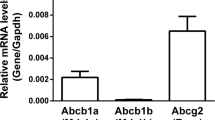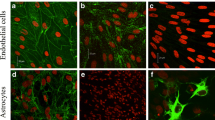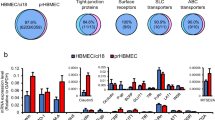No Heading
Purpose.
To examine the capability of a fluorometric assay to identify and characterize the drug efflux interactions of a broad spectrum of drug agents in an in vitro model of the blood-brain barrier (BBB).
Methods.
Various concentrations of drug agent (1, 10, and 100 μM) were evaluated for their effect on the cellular accumulation of the P-glycoprotein (P-gp) probe R123 (3.2 μM), and the mixed P-gp and multidrug resistance-associated protein (MRP) probe, BCECF (1 μM), in bovine brain microvessel endothelial cell (BBMEC) monolayers. Drugs demonstrating a significant effect were further quantitated using an expanded concentration range and a nonlinear regression curve fit to determine the potency (IC50) and efficacy (Imax) of the drug for P-gp and/or MRP.
Results.
Several of the 36 therapeutic agents examined showed drug efflux transporter interactions in BBMEC monlayers. Melphalan and risperidone significantly enhanced the accumulation of R123 over control (1.47- and 1.82-fold, respectively) with resulting IC50s of 1.4 and 14.6 μM, respectively. Chlorambucil and valproic acid significantly enhanced the accumulation of BCECF compared to control monolayers (2.02- and 4.01-fold, respectively) with resulting IC50s of 146.1 and 768.5 μM, respectively.
Conclusions.
The current study demonstrates the feasibility of a fluorometric assay consisting of R123 and BCECF in assessing the drug efflux interactions of a variety of drugs in the BBB.
Similar content being viewed by others
References
1. C. Cordon-Cardo, J. O’Brien, J. Boccia, D. Casals, J. Bertino, and M. Melamed. Expression of the multidrug-resistance gene product (P-glycoprotein) in human normal and tumor tissues. J. Histochem. Cytochem. 38:1277–1287 (1990).
2. J. Hooijberg, H. Broxterman, M. Kool, Y. Assaraf, G. Peters, P. Noordhuis, R. Scheper, P. Borst, H. Pinedo, and G. Jansen. Antifolate resistance mediated by the multidrug resistance proteins MRP1 and MRP2. Cancer Res. 59:2532–2535 (1999).
3. M. Kool, M. de Haas, G. L. Scheffer, R. J. Scheper, M. J. van Eijk, J. A. Juijn, F. Baas, and P. Borst. Analysis of expression of cMOAT (MRP2), MRP3, MRP4, and MRP5, homologues of the multidrug resistance-associated protein gene (MRP1), in human cancer cell lines. Cancer Res. 57:3537–3547 (1997).
4. L. Doyle, W. Yang, L. Abruzzo, T. Krogmann, Y. Gao, A. Rishi, and D. Ross. A multidrug resistance transporter from human MCF-7 breast cancer cells. Proc. Natl. Acad. Sci. USA 95:15665–15670 (1998).
5. A. Schinkel and J. Jonker. Mammalian drug efflux transporters of the ATP binding cassette (ABC) family: an overview. Adv. Drug Deliv. Rev. 55:3–29 (2003).
6. C. Cordon-Cardo, J. O’Brien, D. Casals, L. Rittman-Grauer, J. Biedler, M. Melamed, and J. Bertino. Multidrug-resistance gene (P-glycoprotein) is expressed by endothelial cells at blood-brain barrier sites. PNAS USA 86:695–698 (1989).
7. H. Huai-Yun, D. T. Secrest, K. S. Mark, D. Carney, C. Brandquist, W. F. Elmquist, and D. W. Miller. Expression of multidrug resistance-associated protein (MRP) in brain microvessel endothelial cells. Biochem. Biophys. Res. Commun. 243:816–820 (1998).
8. H. Kusuhara, H. Suzuki, M. Naito, T. Tsuruo, and Y. Sugiyama. Characterization of efflux transport of organic anions in a mouse brain capillary endothelial cell line. J. Pharmacol. Exp. Ther. 285:1260–1265 (1998).
9. T. Eisenblatter, S. Huwel, and H. Galla. Characterisation of the brain multidrug resistance protein (BMDP/ABCG2/BCRP) expressed at the blood-brain barrier. Brain Res. 971:221–231 (2003).
10. T. Eisenblatter and H. Galla. A new multidrug resistance protein at the blood-brain barrier. Biochem. Biophys. Res. Commun. 293:1273–1278 (2002).
11. H. Cooray, C. Blackmore, L. Maskell, and M. Barrand. Localisation of breast cancer resistance protein in microvessel endothelium of human brain. Neuroreport 13:2059–2063 (2002).
12. P. van der Valk, C. van Kalken, H. Ketelaars, H. Broxterman, G. Scheffer, C. Kuiper, T. Tsuruo, J. Lankelma, C. Meijer, and H. Pinedo. Distribution of multi-drug resistance-associated P-glycoprotein in normal and neoplastic human tissues. Analysis with 3 monoclonal antibodies recognizing different epitopes of the P-glycoprotein molecule. Ann. Oncol. 1:56–64 (1990).
13. F. Thiebaut, T. Tsuruo, H. Hamada, M. Gottesman, I. Pastan, and M. Willingham. Cellular localization of the multidrug-resistance gene product P-glycoprotein in normal human tissues. PNAS USA 84:7735–7738 (1987).
14. V. D. Makhey, A. Guo, D. A. Norris, P. Hu, J. Yan, and P. J. Sinko. Characterization of the regional intestinal kinetics of drug efflux in rat and human intestine and in Caco-2 cells. Pharm. Res. 15:1160–1167 (1998).
15. K. C. Peng, F. Cluzeaud, M. Bens, J. P. Van Huyen, M. A. Wioland, R. Lacave, and A. Vandewalle. Tissue and cell distribution of the multidrug resistance-associated protein (MRP) in mouse intestine and kidney. J. Histochem. Cytochem. 47:757–768 (1999).
16. M. Maliepaard, G. Scheffer, I. Faneyte, M. van Gastelen, A. Pijnenborg, A. Schinkel, M. van de Vijver, R. Scheper, and J. Schellens. Subcellular localization and distribution of the breast cancer resistance protein in normal human tissues. Cancer Res. 61:3458–3464 (2001).
17. J. Konig, D. Rost, Y. Cui, and D. Keppler. Characterization of the human multidrug resistance protein isoform MRP3 localized to the basolateral hepatocyte membrane. Hepatology 29:1156–1163 (1999).
18. M. Muller, H. Roelofsen, and P. L. Jansen. Secretion of organic anions by hepatocytes: involvement of homologues of the multi-drug resistance protein. Semin. Liver Dis. 16:211–220 (1996).
19. I. Sugawara, I. Kataoka, Y. Morishita, H. Hamada, T. Tsuruo, S. Itoyama, and S. Mori. Tissue distribution of P-glycoprotein encoded by a multidrug-resistant gene as revealed by a monoclonal antibody, MRK 16. Cancer Res. 48:1926–1929 (1988).
20. S. Ernest, S. Rajaraman, J. Megyesi, and E. Bello-Reuss. Expression of MDR1 (multidrug resistance) gene and its protein in normal human kidney. Nephron 77:284–289 (1997).
21. H. Kusuhara and Y. Sugiyama. Role of transporters in the tissue-selective distribution and elimination of drugs: transporters in the liver, small intestine, brain and kidney. J. Control. Rel. 78:43–54 (2002).
22. C. J. Bachmeier, W. J. Trickler, and D. W. Miller. Drug efflux transport properties of 2′,7′-bis(2-carboxyethyl)-5(6)-carboxy-fluorescein acetoxymethyl ester (BCECF-AM) and its fluorescent free acid, BCECF. J. Pharm. Sci. 93:932–942 (2004).
23. D. W. Miller, K. L. Audus, and R. T. Borchardt. Application of cultured bovine brain endothelial cells in the study of the blood-brain barrier. J. Tissue Cult. Methods 14:217–224 (1992).
24. F. Hyafil, C. Vergely, P. Du Vignaud, and T. Grand-Perret. In vitro and in vivo reversal of multidrug resistance by GF120918, an acridonecarboxamide derivative. Cancer Res. 53:4595–4602 (1993).
25. M. de Bruin, K. Miyake, T. Litman, R. Robey, and S. Bates. Reversal of resistance by GF120918 in cell lines expressing the ABC half-transporter, MXR. Cancer Lett. 146:117–126 (1999).
26. A. Wallstab, M. Koester, M. Bohme, and D. Keppler. Selective inhibition of MDR1 P-glycoprotein-mediated transport by the acridone carboxamide derivative GG918. Br. J. Cancer 791053–1060 (1999).
27. W. Chen, K. Luker, J. Dahlheimer, C. Pica, G. Luker, and D. Piwnica-Worms. Effects of MDR1 and MDR3 P-glycoproteins, MRP1, and BCRP/MXR/ABCP on the transport of (99m)Tc -tetrofosmin. Biochem. Pharmacol. 60:413–426 (2000).
28. T. Litman, M. Brangi, E. Hudson, P. Fetsch, A. Abati, D. Ross, K. Miyake, J. Resau, and S. Bates. The multidrug-resistant phenotype associated with overexpression of the new ABC half-transporter, MXR (ABCG2). J. Cell Sci. 113:2011–2021 (2000).
29. D. Kessel, W. Beck, D. Kukuruga, and V. Schulz. Characterization of multidrug resistance by fluorescent dyes. Cancer Res. 51:4665–4670 (1991).
30. M. Fontaine, W. F. Elmquist, and D. W. Miller. Use of rhodamine 123 to examine the functional activity of P-glycoprotein in primary cultured brain microvessel endothelial cell monolayers. Life Sci. 59:1521–1531 (1996).
31. J. Park, S. Lee, I. Hong, H. Kim, K. Lim, K. Choe, W. Kim, Y. Kim, T. Tsuruo, and M. Gottesman. MDR1 gene expression: its effect on drug resistance to doxorubicin in human hepatocellular carcinoma cell lines. J. Natl. Cancer Inst. 86:700–705 (1994).
32. S. Horwitz, D. Cohen, S. Rao, I. Ringel, H. Shen, and C. Yang. Taxol: mechanisms of action and resistance. J. Natl. Cancer Inst. Monogr. 15:55–61 (1993).
33. C. Galmarini. P-glycoprotein expression by cancer cells affects cell cytotoxicity and cell-cycle perturbations induced by six chemotherapeutic drugs. J. Exp. Ther. Oncol. 2:146–152 (2002).
34. J. Drewe, H. Ball, C. Beglinger, B. Peng, A. Kemmler, H. Schachinger, and W. Haefeli. Effect of P-glycoprotein modulation on the clinical pharmacokinetics and adverse effects of morphine. Br. J. Clin. Pharmacol. 50:237–246 (2000).
35. S. Letrent, G. Pollack, K. Brouwer, and K. Brouwer. Effect of GF120918, a potent P-gp inhibitor, on morphine pharmacokinetics and pharmacodynamics in the rat. Pharm. Res. 15:599–605 (1998).
36. S. Letrent, G. Pollack, K. Brouwer, and K. Brouwer. Effects of a potent and specific P-glycoprotein inhibitor on the blood-brain barrier distribution and antinociceptive effect of morphine in the rat. Drug Metab. Dispos. 27:827–834 (1999).
37. D. Boulton, C. DeVane, H. Liston, and J. Markowitz. In vitro P-glycoprotein affinity for atypical and conventional antipsychotics. Life Sci. 71:163–169 (2002).
38. D. Averill-Bates and B. Courtemanche. The effect of hyperthermia and verapamil on melphalan cytotoxicity and transport in multidrug-resistant Chinese hamster ovary cells. Radiat. Res. 143:17–25 (1995).
39. D. Averill and B. Larrivee. Hyperthermia, cyclosporine A and melphalan cytotoxicity and transport in multidrug resistant cells. Int. J. Hyperthermia 14:583–588 (1998).
40. C. Murray, M. Quaglia, J. Arnason, and C. Morris. A putative nicotine pump at the metabolic blood-brain barrier of the tobacco hornworm. J. Neurobiol. 25:23–34 (1994).
41. L. Gaertner, C. Murray, and C. Morris Transepithelial transport of nicotine and vinblastine in isolated malpighian tubules of the tobacco hornworm (Manduca sexta) suggests a P-glycoprotein-like mechanism. J. Exp. Biol. 201:2637–2645 (1998).
42. A. H. Schinkel, E. Wagenaar, C. A. Mol, and L. van Deemter. P-glycoprotein in the blood-brain barrier of mice influences the brain penetration and pharmacological activity of many drugs. J. Clin. Invest. 97:2517–2524 (1996).
43. A. Tsuji. P-glycoprotein-mediated efflux transport of anticancer drugs at the blood-brain barrier. Ther. Drug Monit. 20:588–590 (1998).
44. E. Batrakova, S. Li, D. Miller, and A. Kabanov. Pluronic P85 increases permeability of a broad spectrum of drugs in polarized BBMEC and Caco-2 cell monolayers. Pharm. Res. 16:1366–1372 (1999).
45. J. P. Gibbs, M. C. Adeyeye, Z. Yang, and D. D. Shen. Valproic acid uptake by bovine brain microvessel endothelial cells: role of active efflux transport. Epilepsy Res. 58:53–66 (2004).
46. P. Borst, R. Evers, M. Kool, and J. Wijnholds. A family of drug transporters: the multidrug resistance-associated proteins. J. Natl. Cancer Inst. 92:1295–1302 (2000).
47. H. Zeng, G. Liu, P. Rea, and G. Kruh. Transport of amphipathic anions by human multidrug resistance protein 3. Cancer Res. 60:4779–4784 (2000).
48. S. Kamazawa, J. Kigawa, Y. Minagawa, H. Itamochi, M. Shimada, M. Takahashi, S. Sato, R. Akeshima, and N. Terakawa. Cellular efflux pump and interaction between cisplatin and paclitaxel in ovarian cancer cells. Oncology 59:329–335 (2000).
49. K. Barnouin, I. Leier, G. Jedlitschky, A. Pourtier-Manzanedo, J. Konig, W. Lehmann, and D. Keppler. Multidrug resistance protein-mediated transport of chlorambucil and melphalan conjugated to glutathione. Br. J. Cancer 77:201–209 (1998).
50. C. Paumi, B. Ledford, P. Smitherman, A. Townsend, and C. Morrow. Role of multidrug resistance protein 1 (MRP1) and gluta-thione S-transferase A1-1 in alkylating agent resistance. J. Biol. Chem. 276:7952–7956 (2001).
51. C. Morrow, P. Smitherman, S. Diah, E. Schneider, and A. Townsend. Coordinated action of glutathione S-transferases (GSTs) and multidrug resistance protein 1 (MRP1) in antineoplastic drug detoxification. Mechanism of GST A1-1- and MRP1-associated resistance to chlorambucil in MCF7 breast carcinoma cells. J. Biol. Chem. 273:20114–20120 (1998).
52. D. Sugiyama, H. Kusuhara, Y. J. Lee, and Y. Sugiyama. Involvement of multidrug resistance associated protein 1 (Mrp1) in the efflux transport of 17beta estradiol-D-17beta-glucuronide (E217betaG) across the blood-brain barrier. Pharm. Res. 20:1394–1400 (2003).
53. Y. Zhang, J. D. Schuetz, W. F. Elmquist, and D. W. Miller. Plasma membrane localization of multidrug resistance-associated protein (MRP) homologues in brain capillary endothelial cells. J. Pharmacol. Exp. Ther. (2004).
54. C. Wandel, R. Kim, M. Wood, and A. Wood. Interaction of morphine, fentanyl, sufentanil, alfentanil, and loperamide with the efflux drug transporter P-glycoprotein. Anesthesiology 96913–920 (2002).
55. J. Polli, S. Wring, J. Humphreys, L. Huang, J. Morgan, L. Webster, and C. Serabjit-Singh. Rational use of in vitro P-glycoprotein assays in drug discovery. J. Pharmacol. Exp. Ther. 299:620–628 (2001).
56. Z. Hollo, L. Homolya, T. Hegedus, and B. Sarkadi. Transport properties of the multidrug resistance-associated protein (MRP) in human tumour cells. FEBS Lett. 383:99–104 (1996).
57. Y. Zhang, H. Han, W. Elmquist, and D. Miller. Expression of various multidrug resistance-associated protein (MRP) homologues in brain microvessel endothelial cells. Brain Res. 876:148–153 (2000).
58. O. V. Olesen, R. W. Licht, E. Thomsen, T. Bruun, J. E. Viftrup, and K. Linnet. Serum concentrations and side effects in psychiatric patients during risperidone therapy. Ther. Drug Monit. 20:380–384 (1998).
Author information
Authors and Affiliations
Corresponding author
Rights and permissions
About this article
Cite this article
Bachmeier, C., Miller, D. A Fluorometric Screening Assay for Drug Efflux Transporter Activity in the Blood-Brain Barrier. Pharm Res 22, 113–121 (2005). https://doi.org/10.1007/s11095-004-9016-0
Received:
Accepted:
Published:
Issue Date:
DOI: https://doi.org/10.1007/s11095-004-9016-0




